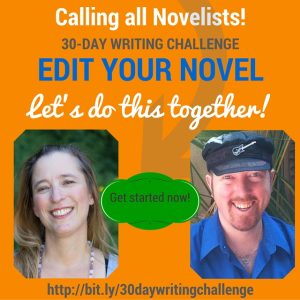Write Your Story Synopsis with a Plug-and-Play Tool
Todays’ guest post is by Beth Barany.
There are brainstorming exercises you can take to plan your novel that are fun, take a short amount of time, and keep your enthusiasm up.
In my Plan Your Novel: 30-Day Writing Challenge course, we teach an accordion method that encourages you to start small and expand your story ideas outward.
In this post, I share one of the essential tools on story planning: how to write your story synopsis in a simple way: with a plug-and-play tool.
(For a list of other essential novel planning tools click HERE.)
A synopsis is a short summary of your book.
In the planning stages, a synopsis can help you think through the beginning, middle, and end of your story. I like to draft the story synopsis as a way to think about the inner and outer changes for my two main characters.
Tip: If you do plan to pitch your story to a literary agent, you’ll need a synopsis. Once your novel is polished, you can come back to your draft synopsis to edit or use for inspiration.
I have a cool tool to share with you called a “Plot Spinner,” designed by the award-winning romance author Patricia Simpson. She built this tool based on an exercise by writing teacher Alicia Rasley.
Keep in mind: Take note of your genre. This will give you a general ideal of your story ending. If you’re not sure about your genre, make your best guess. This is brainstorming. You can always edit this later.
Next: Use the following Plot Spinner Tool.
I really like this tool because all you need to do is answer the questions, click a button, and you’ll have a several-paragraph synopsis.
Note: This tool is designed for romance writers, threading the story of a hero and heroine and their relationship. Adapt as needed.
Action: Go here to use the Plot Spinner.
Time to budget: I recommend you take 30-60 minutes to do this exercise.
You can also use this outline and do the Plot Spinner by hand. Here’s the structure and an example by novelist Patricia Simpson:
- One-sentence summary paragraph (like a movie listing on TV)
- What issue you are exploring. Mine was trust.
- Premise. The idea you want to prove or disprove by the end of the story.
Examples:
“You can never go home again.”
“There IS such a thing as love at first sight.”
“To find a sense of home, sometimes you have to leave it.”
- Simplify your basic story by writing ONE sentence for each of these (keeping your issue in mind):
Heroine’s external struggle because of issue:
a. At the beginning. (Divorce, caused by lack of intimacy, has caused loss of house.)
b. In the middle (Tatiana is kidnapped when she trusts villain.)
c. At the end (Tatiana must trust Ren to find treasure to get house back.)
Heroine’s internal struggle with issue:
d. At the beginning (Tatiana doesn’t trust men.)
e. the middle (Tatiana finds out Ren is using her to break spell.)
f. At the end (Tatiana learns she has to trust herself FIRST before she can trust men.)
Hero’s external struggle with issue:
g. At the beginning. (Ren has to woo a woman to break the spell.)
h. In the middle (Ren realizes he will probably die before he seduces Tatiana.)
i. At the end (Ren chooses death to help Tatiana save her home.)
Hero’s internal struggle:
j. At the beginning (Women are to be revered or bedded, not befriended.)
k. In the middle (Ren is confused about his growing admiration & lust for Tatiana.)
l. At the end (Ren gets to know and trust a woman for the first time in his life)
H&H interaction:
m. At the beginning (Against his better judgment, Ren offers his services to Tatiana.)
n. In the middle (Just when she is softening toward him, she finds out why he is wooing her.)
o. At the end (Tatiana must trust Ren implicitly to save the house.)
Now take the above sentences and arrange them like this:
a, d, g, j, m
b, e, h, k, n
c, f, I, l, o
PRESTO! CHANGO! You should have the basic path of your story in 15 sentences.
String them together with modifying phrases to make sense. Then write the synopsis.

The Night Orchid by Patricia Simpson
Patricia Simpson is described by reviewers as “a premier writer of supernatural romance.” Author of numerous paranormal novels, she is inspired by science, paranormal phenomena, and archeological discoveries, and consistently garners superior ratings and awards for unusual heroes and unpredictable plots. Simpson has been called “a master at keeping suspense going on a multitude of levels,” and a “masterful storyteller.”
WANT MORE TIPS IN PLANNING YOUR NOVEL?
Then get the tip sheet, “10 Questions to Ask Your Characters” HERE.
READY TO SIGN UP FOR OUR UPCOMING COURSE?
We’re gearing up to start our 4th Annual Plan Your Novel course. If you’d like hands-on support with your peers and with two experienced instructors — Beth and Ezra Barany have over twenty published novels and novellas between then, then join us for our next course starting October 1st: 30-Day Writing Challenge to Plan Your Novel.
 Award-winning novelist in YA fantasy, Master NLP Practitioner, and certified creativity coach for writers, Beth Barany offers courses packed with useful hands-on information that you can implement right away. Beth runs the Writer’s Fun Zone blog, for and by creative writers, where you can download her free reports on book marketing and novel writing. She is also the author of The Writer’s Adventure Guide, Overcome Writer’s Block, and Twitter for Authors.
Award-winning novelist in YA fantasy, Master NLP Practitioner, and certified creativity coach for writers, Beth Barany offers courses packed with useful hands-on information that you can implement right away. Beth runs the Writer’s Fun Zone blog, for and by creative writers, where you can download her free reports on book marketing and novel writing. She is also the author of The Writer’s Adventure Guide, Overcome Writer’s Block, and Twitter for Authors.










